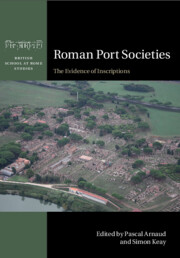Book contents
- Roman Port Societies
- British School at Rome Studies
- Roman Port Societies
- Copyright page
- Contents
- Figures
- Tables
- Contributors
- Abbreviations
- 1 The Context of Roman Mediterranean Port Societies
- 2 Inscriptions and Port Societies
- 3 Stationes and Associations of Merchants at Puteoli and Delos
- 4 Boatmen and their Corpora in the Great Ports of the Roman West (Second to Third Centuries AD)
- 5 Roman Port Societies and Their Collegia
- 6 Port Occupations and Social Hierarchies
- 7 Warehouse Societies
- 8 The Imperial Cult and the Sacred Bonds of Roman Overseas Commerce
- 9 Law and Life in Roman Harbours
- 10 Living Like a Cosmopolitan?
- 11 Ports, Trade and Supply Routes in Western Europe
- 12 The Port Society of Narona
- 13 Municipal Authority, Central Authority and Euergetists at Work at the Port
- 14 The Structure of Mercantile Communities in the Roman World
- 15 Polysemy, Epigraphic Habit and Social Legibility of Maritime Shippers
- 16 Reading Roman Port Societies
- Indexes
- References
12 - The Port Society of Narona
Published online by Cambridge University Press: 30 October 2020
- Roman Port Societies
- British School at Rome Studies
- Roman Port Societies
- Copyright page
- Contents
- Figures
- Tables
- Contributors
- Abbreviations
- 1 The Context of Roman Mediterranean Port Societies
- 2 Inscriptions and Port Societies
- 3 Stationes and Associations of Merchants at Puteoli and Delos
- 4 Boatmen and their Corpora in the Great Ports of the Roman West (Second to Third Centuries AD)
- 5 Roman Port Societies and Their Collegia
- 6 Port Occupations and Social Hierarchies
- 7 Warehouse Societies
- 8 The Imperial Cult and the Sacred Bonds of Roman Overseas Commerce
- 9 Law and Life in Roman Harbours
- 10 Living Like a Cosmopolitan?
- 11 Ports, Trade and Supply Routes in Western Europe
- 12 The Port Society of Narona
- 13 Municipal Authority, Central Authority and Euergetists at Work at the Port
- 14 The Structure of Mercantile Communities in the Roman World
- 15 Polysemy, Epigraphic Habit and Social Legibility of Maritime Shippers
- 16 Reading Roman Port Societies
- Indexes
- References
Summary
The title of this chapter may seem provocative. While aport society is typically perceived to be anunambiguous concept, it is an anachronistic one whenapplied to the ancient world. 1It has yetto be conclusively proven that societies living inareas connected by waterways, and therefore withaccess to major commercial routes, differedsignificantly from other land-based urbansettlements of equal size. However, we ought topause here a moment to observe an undoubted fact,especially evident for example in Hispania: thesocial behaviours of coastal cities differ fromthose of inland settlements of a similar scale. Theevidence related to social promotion is crucial inthis case, with freedmen playing a key role. Incontrast, the noted social conservatism of inlandsocieties has contributed to the creation of a powerstruggle between such open and closedsocieties.2 Perhaps this is not theforum to discuss and clarify these issues, but itcan be argued that the society of Narona was an openone, and its port access can be considered anessential determinant of this characteristic, as itwas for most coastal cities for which there issufficient historical information. Furthermore, itslocation at the midpoint of the north Adriaticmaritime trade route enhanced the significance ofthe city.3
- Type
- Chapter
- Information
- Roman Port SocietiesThe Evidence of Inscriptions, pp. 266 - 291Publisher: Cambridge University PressPrint publication year: 2020



